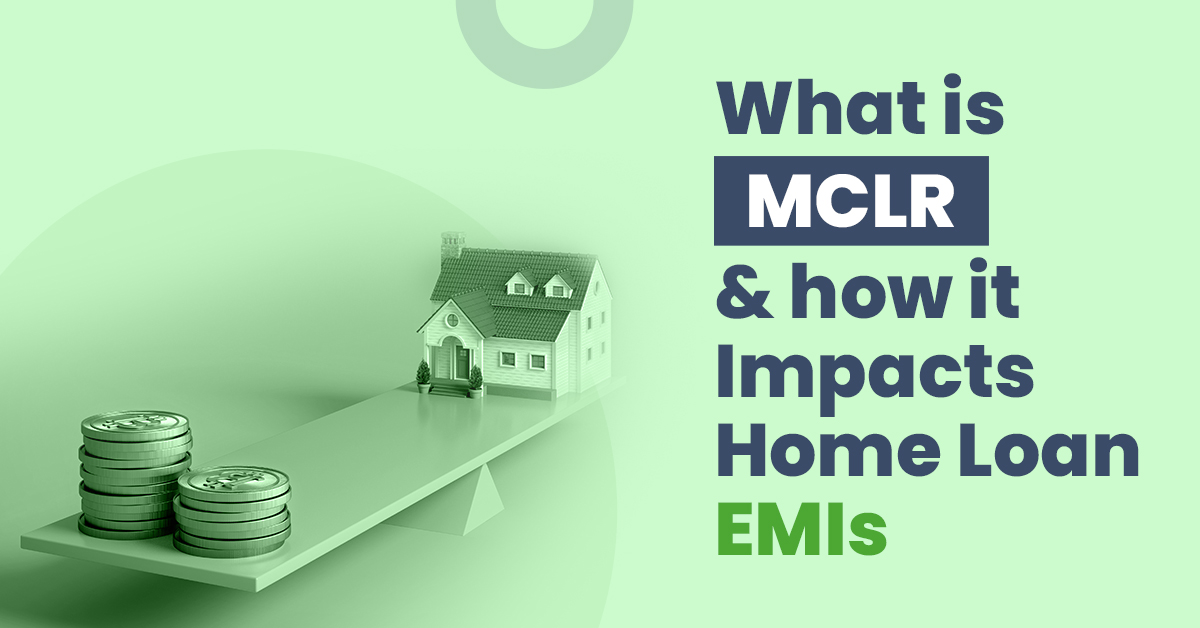What is MCLR and How Does it Impact Your Home Loan EMIs?


The interest rate chargeable on your home loan is determined using the Marginal Cost of Funds Based Lending Rate (MCLR). It is of utmost importance to know if and how the MCLR affects the home loan and its EMI payments.
As the MCLR grows, so do the interest payments made by borrowers. Therefore, existing borrowers’ EMIs will be impacted by the rise in the MCLR when their loan reset dates come around. A loan reset date marks when the initial fixed interest rate turns into an adjustable rate. This date is typically one to five years after the loan’s start date.
MCLR: What Is It?
The marginal cost of funds based lending rate, also known as the MCLR, is the name given to the minimum interest rate that banks and other financial institutions can charge. MCLR replaced the earlier base rate system to determine the lending rates for commercial banks.
Excluding some special cases banks cannot lend money to individuals at interest rates below a predetermined minimum – this is the MCLR. This is done to prevent lenders from engaging in favouritism and prioritising lending loans to certain individuals at a lower rate than others.
So, what is the chargeable rate of MCLR? Who gets to decide this? The Reserve Bank of India (RBI) has established rules regarding the minimum MCLR that banks may charge while providing loans. The RBI has issued a formula to calculate MCLR:
Marginal cost of funds = (92% of Marginal cost of borrowings) + (8% of Return on net worth)
Essential Points About MCLR
- MCLR applies only to commercial banks and does not apply to Non-banking Financial Companies (NBFCs).
- It is applicable on floating interest rates and fixed rates of up to three years.
- It is to be published every month by banks for at least five tenures:
- Overnight MCLR
- One-month MCLR
- Three-month MCLR
- Six-month MCLR
- One-year MCLR
Factors Considered While Calculating MCLR
Let’s discuss the four major components taken into consideration while computing the MCLR:
- Tenure Premium: The borrowing cost depends on the loan’s tenure. Longer the loan term, greater the uncertainty. As such, the bank will charge a sum as a premium to cover the risk, shifting the burden to borrowers.
- Marginal Cost of Funds: The marginal cost of funds is the average rate which banks provide to their deposit holders with similar maturities.the marginal cost of funds has several components like the Return on Net Worth and the Marginal Cost of Borrowings. Marginal Cost of Borrowings takes up 92% while the Return on Net Worth accounts for 8%.
- Operating Costs: Banks may calculate other operating costs as a percentage of the marginal cost of funds for computing MCLR.
- Negative Carry-on Cash Reserve Ratio (CRR): CRR refers to the requirement wherein all banks are mandated to maintain a prescribed amount of their funds with the RBI as reserves. The RBI does not pay any interest on the CRR to the banks. Since there is no interest paid on CRR, the actual return is less than the cost of funds, thereby giving a negative carry to banks. The Negative Carry-on CRR can also be considered in computing the MCLR.
How Does a Hike in Repo Rates Affect the MCLR?
The RBI increases or decreases the repo rate to control the inflation in the overall economy. Inflation is when the prices of goods and services go up. The RBI is tasked with balancing inflation and economic growth. When the RBI wants to increase the cost of borrowing, it increases the repo rate. A hike in interest rates means that the general public cannot borrow money at low rates, which limits their spending, reducing demand, which in turn keeps inflation in control. On the other hand, the RBI decreases the repo rate when a decrease in the cost of borrowing is needed to provide growth or healthy inflation. Once the cost of borrowing is less, people can borrow money at lower interest rates, which leads to increased spending, leading to a rise in the prices of goods and services (i.e., inflation).
MCLR and Home Loans
MCLR, as opposed to the base rate scheme, may undoubtedly transfer the advantages of repo rate fluctuations to the end-consumers. This is so that the MCLR system can immediately adapt to any instructions from the RBI about the repo rates. Additionally, banks must now set various MCLRs according to loan tenure. This could happen every day, every month, every four months, or every year. Therefore, if you are a home loan borrower and take out a loan at the quarterly MCLR, your home loan interest rate may change every three months, thereby affecting your EMI amount. Similarly, suppose you successfully obtain a home loan at an annual MCLR. In that case, you will continue to make payments on the interest rate as agreed upon, regardless of changes in repo rates during the year.
How Does MCLR Impact Home Loans EMIs?
The MCLR interest rate has a direct impact on your home loan EMI. Naturally, an increase in the interest rate leads to a subsequent increase in your liability towards a loan. With the increasing liability, your EMI’s duration would increase accordingly. For example, if previously you were to pay a sum of, say, ₹50,000 and now, with an increase in MCLR, your liability might have increased to, say, ₹55,000. With this increase in liability, your monthly payments and loan term will alter in response to changes in the MCLR. Conversely, if the MCLR decreases, the EMI or duration may also decrease. Additionally, it makes it simpler for borrowers to receive the advantages of lower interest rates.
Things to Consider Regarding MCLR on Home Loans:
- Only home loans with fluctuating interest rates, not fixed interest rates, are eligible for the benefits of MCLR.
- Choose the prepayment option for your home loan to negate the impact of the difference in interest rates.
- Request a cost-benefit analysis that is comprehensive and appropriate before changing your home loan to a fixed rate. A cost-benefit analysis gives us a better understanding of the loan’s benefits compared to its costs.
Final Word
An MCLR rate policy provides the borrowers with several perks, the primary one being changing alongside the change in the repo rates by the RBI. It also benefits the RBI by fulfilling the very purpose of repo operations, which is helping to achieve the objective of inflation control. A conversion to MCLR is an option for borrowers repaying house loans obtained at earlier base rates. They might, however, be required to pay a conversion fee.
Frequently Asked Questions (FAQs)
Does a hike in the MCLR affect my home loan EMI?
Yes, home loan EMIs will increase with an increase in MCLR rates, and vice-versa.
Will a hike in repo rate affect my MCLR-based loan?
Yes, repo rates have a direct impact on MCLR rates.
Can I shift my loan from a base rate policy to an MCLR one?
Yes, you can shift your base rate loan to an MCLR-based loan.



